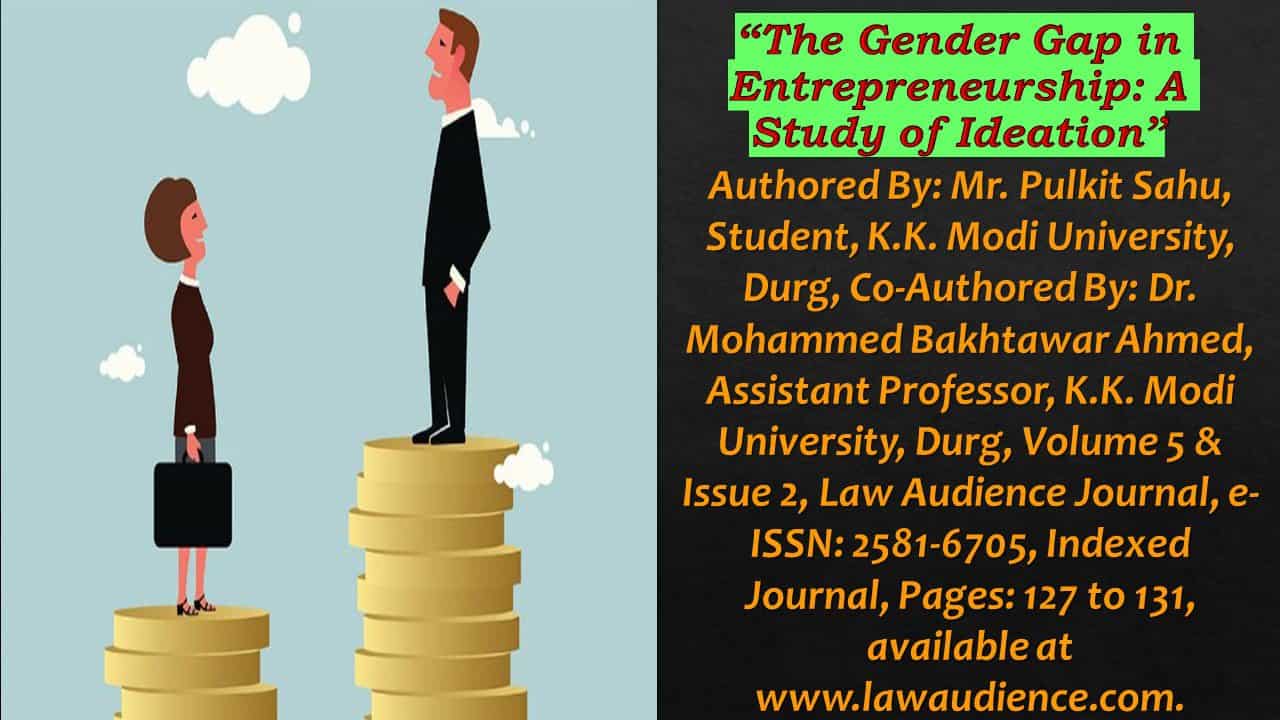Click here to download the full paper (PDF)
Authored By: Mr. Pulkit Sahu, Student, K.K. Modi University, Durg, Co-Authored By: Dr. Mohammed Bakhtawar Ahmed, Assistant Professor, K.K. Modi University, Durg,
Click here for Copyright Policy.
ABSTRACT:
“Data from various countries exhibit gender opening in entrepreneurship. The opening is greater when stood out from the labor force participation in various regions. The case in India isn’t all that remarkable all the while. There are various monetary explanations on this opening found recorded as a hard copy, recollecting the occupation of individuals for raising a family. The monetary issues viewpoint is credited to a disservice in having the components of creation by women. the ownership shortcoming doesn’t figure out the opening totally in all areas. More number of entrepreneurs pick organization regions for section and this region requires the customary factors of creation to a lesser extent. Subsequently the gender opening in entrepreneurship isn’t totally sensible on this reason. For several in switch states in eastern India, the gender opening is altogether more opposing. This investigation paper, taking the case of eastern-Odisha, India, focuses on a piece of the factors drew in with huge business improvement and endeavors to look at from an attitudinal perspective and endeavors to isolate the proclivities of women concerning men and endeavors to give a social, attitudinal, mental explanation to such differentiations”.
Keywords: Entrepreneurship, Gender, business, Organization, improvement.
I. INTRODUCTION:
Formation of any association or undertaking, is essentially friendly in nature. Anyway support and commitment in making an undertaking is viewed till date as slanted across gender. Men keep on ruling in the field of entrepreneurship. The distinction with deference to gender has been credited to underlying place of ladies in the public eye or relational distinction across gender. For what reason is there such a gender hole in entrepreneurship development, and where could there be any extension for conceivable improvement? Is there any hole, additionally in the impression of women entrepreneurs? Self-employed persons are defined as individuals who operated their own farm or non-farm enterprises or were engaged independently in a profession or trade on own-account or with one or a few partners. The distinctive features are indicated by having autonomy (decide how, where and when to produce) and economic independence (in respect of choice of market, scale of operation and finance). The remuneration is deemed to have components as reward for their labor and profit of their enterprise. The self-employment data, labor-force participation data and women owned MSME data indicate that the participation is much less in case of women than men.
I.I Objectives of the study:
The study tries to identify differences of various factors influencing entrepreneurship between the genders. Women, as economic agents; in India, are experiencing changes in education, empowerment, legal framework, policy support and preference in career choices. These changes are expected to influence the choice of entrepreneurship, the study would support it by providing the evidence base.
I.II Methodology:
This study warranted empirical survey of entrepreneurs of Khurda district of Odisha (India), through a structured questionnaire measuring selected variables, covering both qualitative and quantitative aspects of research. Ideal situation of ‘stratified random sampling’ was not feasible, because of reluctance/ un-availability of MSMEs and time-constraint. Hence convenience sampling was adopted.
II. TARGET POPULATION AND SAMPLE:
The geographical scope of this study was limited to Khordha district of Odisha state, in India. As per MSME Report 2012-13, this district had MSME population of 7569. The study considered a convenient sampling method. Initially 250 entrepreneurs were identified and their consent was obtained. 213 valid responses could be obtained for analysis and this contained 53 women entrepreneurs.
II.I CONSTRUCTS AND VARIABLES:
Challenges of doing a business. The entrepreneurs’ perception about the overall challenges forms a part of efficacy. If the individual perceives very high level of challenge in doing a business, then the likelihood of choosing entrepreneurship diminishes. These perceptions are socioeconomic and cultural context specific. The variables for the challenges as a construct, involved following items reflecting following themes: Doing business is easy, business has high uncertainty, no social acceptance for business persons, there are legal issues, it disturbs family life, corruption, competition, lack of knowledge, fund constraint (own fund and loan), lack of government support and good employees, market risks and lack of input resources like raw materials etc.
Sources and Evaluation of Ideas. One of the most important processes of entrepreneurship is to conceptualize, select and freeze on the business idea to work on. There are various sources from which the entrepreneur could get the seed idea. The diversity of sources and ideas are indicative of the robustness of the ideas. In the instrument, indicative sources of ideas were given as media sources, exposure visits, work experience, peer network, resolving an issue faced and serendipity. Respondents are to indicate their choices in Likert scale. Similarly for evaluation of the ideas, entrepreneurs can depend on various sources like; industry expert, friends/colleagues/relatives, banker and may consult industry reports. The entrepreneur can also depend on the gut feel or on own judgment. An entrepreneur develops a stronger conviction about the chosen idea and would plan to commit resources at this phase. Planning. At the planning stage the entrepreneur may search for ways and means to refine the idea to suit the available skills and resources. At this stage, the strategic and execution intent is balanced with the risk mitigation options. The section of the instrument had questions to capture the responses with regard to planning, the entrepreneur went through. The statements were about: ‘Continual search of ideas for fine tuning’; ‘Financial projection’; ‘Devoting adequate time for planning rather than learning on the job’; ‘Written business plan’; and ‘Having a backup plan in case of failure’. These factors were finalized after the pilot study of the instrument. Conviction about success. Sense making about the performance or developing the gut feel about the success takes place, before the actual measurement process is laid out and business performance measurement takes place. A small business entrepreneur in fact keeps doing this process mentally, without an elaborate process or method. To access such conviction, intrinsic ability and the indicative heuristics, the instrument included the following factors; ‘growth in customers’, ‘opinion from experts and peer group’, ‘family’, ‘ability to drive down cost’, ‘technological superiority’, ‘waiting as a strategy’, ‘network building’, ‘comparing the growth of market’ and ‘trust in delivery process’. Responses were sought in a five point Likert scale. Measuring the indication of success. Depending on the strategic intent, entrepreneur deploys various parameters or a combination of parameters, thereof, for measuring the business performance. These measures become of vital importance during the formation period. These measures are process outcomes or input to substantiate any vital process of the new venture.
III. CONCLUSION:
Number of employees during start and currently as a proxy for growth does not indicate any difference across gender. Overall business challenges are perceived by both genders in similar way. Women entrepreneurs have stronger feeling that there is social acceptability of business persons. Compared to men, women feel that the degree of competition is less. Women feel that there is Government support to the entrepreneurs where as men feel that there is no support. Similarly, men agree to the fact that good quality employees are not available whereas women disagree to it. Source and evaluation of ideas seems to be distinct between genders. Women would have fewer sources of ideas but would like to verify the ideas from a greater number of sources before acting on it. There is no difference in the way both gender plans about the new venture. Both the genders don’t display any difference about conviction of business success. Men display difference in the way they measure the business performance as compared to females. There is no difference between genders in their self-evaluation of knowledge before starting the organization. Men respond at a higher level in the ability to differentiate their business as compared to women. Women are more satisfied compared to men with respect to income, savings, social respect and overall satisfaction.
References:
- Dawson, C., & Henley, A. (2015). Gender, risk, and venture creation intentions. Journal of Small Business Management, 53(2), 501-515. doi: 10.1111/jsbm.12080
- https://www.youthbusiness.org/resource/women-face-gender-specific-barriers-to-entrepreneurship#:~:text=Lack%20of%20confidence%20and%20skills,failure%20and%20further%20erodes%20confidence.
- https://www.unicef.org/eap/reports/addressing-gender-barriers-entrepreneurship-and-leadership-among-girls-and-young-women
Cite this article as:
Mr. Pulkit Sahu & Dr. Mohammed Bakhtawar Ahmed, “The Gender Gap in Entrepreneurship: A Study of Ideation”, Vol.5 & Issue 2, Law Audience Journal (e-ISSN: 2581-6705), Pages 127 to 131 (12th June 2023), available at https://www.lawaudience.com/the-gender-gap-in-entrepreneurship-a-study-of-ideation.



